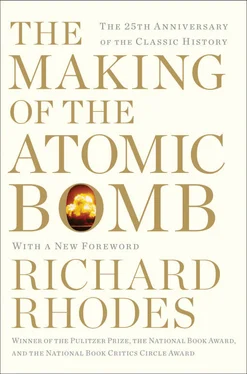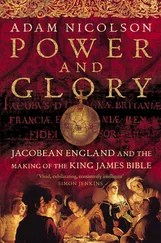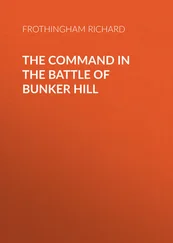As later with other weapons of unfamiliar effect, the chlorine terrorized and bewildered. Men threw down their rifles and decamped. Medical officers at aid stations were suddenly overwhelmed with casualties the cause of whose injuries was unknown. Chemists among the men who survived the attack recognized chlorine quickly enough, however, and knew how easy it was to neutralize; within a week the women of London had sewn 300,000 pads of muslin-wrapped cotton for soaking in hyposulfite—the first crude gas masks. 338
Even though the German High Command allowed the use of gas at Ypres, it apparently doubted its tactical value. It had massed no reserve troops behind the lines to follow up. Allied divisions quickly closed the gap. Nothing came of the attack except agony.
Otto Hahn, a lieutenant in the infantry reserve, helped install the gas cylinders, 5,730 of them containing 168 tons of chlorine, originally at a different place in the line. 339, 340Shovel crews dug them into the forward walls of the trenches at firestep level and sandbagged them thickly to protect them from shellfire. To work them you connected lead pipe to their valves, ran the pipe over the parapet into no-man’s-land, waited for a rocket to signal a start and opened the valves for a predetermined time. Chlorine boils at—28.5° F unpressurized; it boiled out eagerly when released. But the prevailing winds had been wrong where Hahn’s team of Pioniere first installed the chlorine cylinders. By the time the High Command decided to remove them to Ypres along a four-mile front where the wind blew more favorably, Hahn had been sent off to investigate gas-attack conditions in the Champagne.
In January he was ordered to German-occupied Brussels to see Fritz Haber. Haber had just been promoted from reserve sergeant major to captain, an unprecedented leap in rank in the aristocratic Germany Army. He needed the rank, he told Hahn, to accomplish his new work. “Haber informed me that his job was to set up a special unit for gas-warfare.” 341It seems that Hahn was shocked. Haber offered reasons. They were reasons that would be heard again in time of war:
He explained to me that the Western fronts, which were all bogged down, could be got moving again only by means of new weapons. One of the weapons contemplated was poison gas…. When I objected that this was a mode of warfare violating the Hague Convention he said that the French had already started it—though not to much effect—by using rifle-ammunition filled with gas. Besides, it was a way of saving countless lives, if it meant that the war could be brought to an end sooner.
Hahn followed Haber to work on gas warfare. So did the physicist James Franck, head of the physics department at Haber’s institute, who, like Haber and Hahn, would later win the Nobel Prize. 342So did a crowd of industrial chemists employed by I.G. Farben, a cartel of eight chemical companies assembled in wartime by the energetic Carl Duisberg of Bayer. 343The plant at Leverkusen with the new lecture hall turned up hundreds of known toxic substances, many of them dye precursors and intermediates, and sent them off to the Kaiser Wilhelm Institute for Physical Chemistry and Electrochemistry for study. Berlin acquired depots for gas storage and a school where Hahn instructed in gas defense.
He also directed gas attacks. In Galicia on the Eastern Front in mid-June 1915, “the wind was favourable and we discharged a very poisonous gas, a mixture of chlorine and phosgene, against the [Russian] enemy lines…. 344Not a single shot was fired…. The attack was a complete success.” 345
Because of its massive chemical industry, which supplied the world before the war, Germany was far ahead of the Allies in the production of chemicals for gas warfare. Early in the war the British had even been reduced to buying German dyestuffs (not for gas, for dyeing) through neutral countries; when the Germans discovered the subterfuge they proposed, with what compounding of cynicism and labored Teutonic humor the record does not reveal, to trade dyestuffs for scarce rubber and cotton. 346But France and Britain went immediately to work. By the end of the war at least 200,000 tons of chemical warfare agents had been manufactured and used, half by Germany, half by the several Allies together.
Abrogating the Hague Convention opened an array of new ecological niches, so to speak, in weaponry. Types of gas and means of delivery then proceeded to diversify like Darwin’s finches. Germany introduced phosgene next after chlorine, mixing it with chlorine for cloud-gas attacks like Hahn’s because of its slow rate of evaporation. 347The French retaliated in early 1916 with phosgene artillery shells. Phosgene then became a staple of the war, dispensed from cylinders, artillery shells, trench mortars, canisters fired from mortarlike “projectors” and bombs. It smelled like new-mown hay but it was by far the most toxic gas used, ten times as toxic as chlorine, fatal in ten minutes at a concentration of half a milligram per liter of air. At higher concentrations one or two breaths killed in a matter of hours. Phosgene—carbonyl chloride—hydrolyzed to hydrochloric acid in contact with water; that was its action in the water-saturated air deep in the delicate bubbled tissue of the human lung. It caused more than 80 percent of the war’s gas fatalities.
Chlorpicrin—the British called it vomiting gas, the Germans called it Klop —a vicious compound of picric acid and bleaching powder, came along next. 348German engineers used it against Russian soldiers in August 1916. Its special virtue was its chemical inertness. It did not react with the several neutralizing chemicals packed in gas-mask canisters; only the modest layer of activated charcoal in the canisters removed it from the air by adsorption. So a high concentration could saturate the charcoal and get through. It worked like tear gas but induced nausea, vomiting and diarrhea as well. Men raised their masks to vomit; if the Klop had been mixed with phosgene, as it frequently was, they might then be lethally exposed. Chlorpicrin’s other advantage was that it was simple and cheap to make.
The most horrible gas of the war, the gas that started a previously complacent United States developing a chemical-warfare capacity of its own, was dichlorethyl sulfide, known for its horseradish- or mustard-like smell as mustard gas. 349The Germans first used it on the night of July 17, 1917, in an artillery bombardment against the British at Ypres. The attack came as a complete surprise and caused thousands of casualties. Defense in the form of effective masks and efficient gas discipline had caught up with offense by the summer of 1917; Germany introduced mustard gas to break the deadlock, just as it had introduced chlorine before. Shells marked with yellow crosses rained down on the men at Ypres. At first they experienced not much more than sneezing and many put away their masks. Then they began vomiting. Their skin reddened and began to blister. Their eyelids inflamed and swelled shut. They had to be led away blinded to aid stations, more than fourteen thousand of them over the next three weeks.
Though the gas smelled like mustard in dense concentrations, in low concentrations, still extremely toxic, it was hardly noticeable. It persisted for days and even weeks in the field. A gas mask alone was no longer sufficient protection. Mustard dissolved rubber and leather; it soaked through multiple layers of cloth. One man might bring enough back to a dugout on the sole of his boot to blind temporarily an entire nest of his mates. Its odor could also be disguised with other gases. The Germans sometimes chose to disguise mustard with xylyl bromide, a tear gas that smells like lilac, and so it came to pass in the wartime spring that men ran in terror from a breeze scented with blossoming lilac shrubs.
Читать дальше












